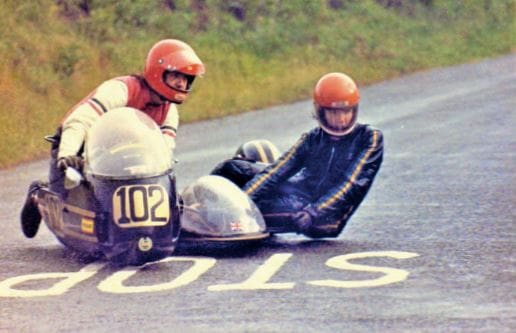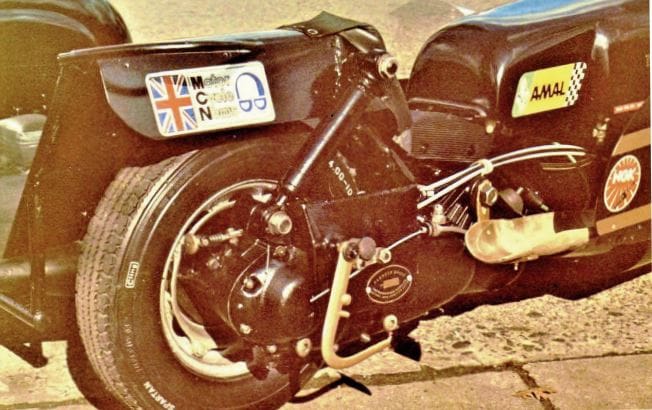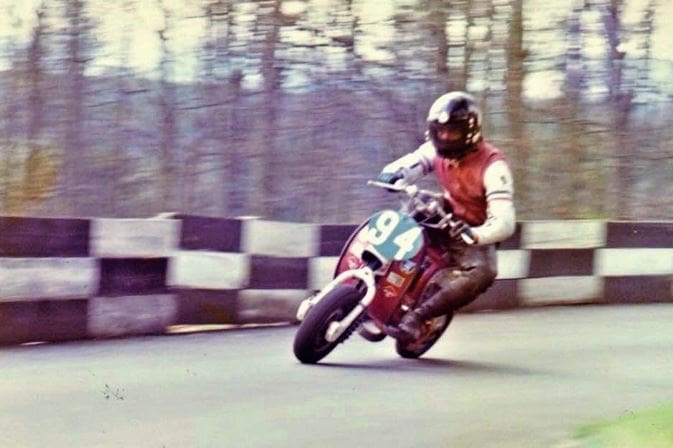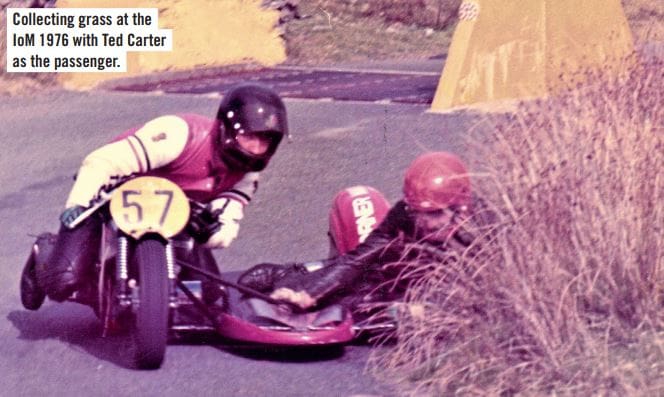There were many scooter clubs that became race oriented and none more so than the Manchester Lyons, many of their members achieving great success.
Ian Mycock or ‘Iggy’, as he was known to his clubmates, started his scooter career in 1965 by way of an old silver Vespa GS, immediately painted bright red once in his possession.

At just 16 years of age he passed his motorbike test, eager to get out on the road with his older brother and friends. It was his brother who had first introduced him to it all by taking him to the 1965 IoM scooter week where he raced for Mancunians Sporting Scooter Club, a breakaway club from the Manchester Lyons.
Still only 15 at the time, Ian was only able to spectate but that didn’t mean he didn’t want to join in and over the next few years would regularly attend events. A lot of these were off-road trials, grass track racing and scrambling or rallies in general as there was no official racing as such.

In the meantime, he had switched allegiance to the Lambretta and started to become influenced by the tuning methods used to make them go faster. As tuning shops started to spring up around the country, the club he was a member of, The Manchester Lyons, became more involved in sporting activities as tuning Lambrettas became the central focus for most of the members.
Malcolm Clarkson had made a couple of trips up to Manchester to talk to the club about tuning methods and set-ups, which may have seemed strange considering he was based in Croydon. Malcolm though was the owner of Supertune which had started to gain recognition as one of the new breed of Lambretta-based tuning shops and saw clubs like the Lyons as a potential customer base.
He was right to think that, as in 1969 Ian took the plunge and bought an SX150 Rallye from the shop.
Ian explained: “I was the first one in our club to have a Supertune Lambretta, delivered by Ron Moss who brought it all the way up from Croydon on the train. Soon others in the club like Bob Melling, Eamon Keher and Jim Davey followed suit, many of us had a Supertune Lambretta.”
For Ian, it meant only one thing: that he was now equipped with the right tool to go scooter racing.

Any race will do
A hazy 1969 was the crossover year for scooter racing as a small championship was run to see if it could go national in 1970.
Up till that point it had consisted of regularity trials that had turned into high-speed events and were what prompted a full race championship to be formed.
For now, it was these disciplines that Ian would participate in, entering his first at Snetterton on his new Supertune machine and, not long after, at the one that had started it all off for him – the IoM scooter week.
He had been part of a three-man team sponsored by Bardahl to enter there a couple of years earlier, only to be cancelled due to a ferry dispute – so it had been a long time coming. It didn’t matter whether it was sand racing, off-road – anything he could participate in Ian entered as he began to learn his trade.
The engine of his SX150 had been tuned by Malcolm Clarkson and Ron Moss and proved to be competitive, but the problem was that the distance involved in getting it sorted became a logistical nightmare.
Closer to home was a lad called Chris Moorehouse, based in Blackpool, who began to work on the engine, which worked well for Ian. As time went by, he would begin to do his own tuning and preparation like many others but for now, this was the best option. Ian would learn from the books that were available at the time and the odd article that was written on the subject; a case of trial and error, with mistakes along the way, but in the end he was producing competitive engines.
Three wheels on my wagon
Racing in the 150cc class was very enjoyable while at the same time competitive which brought Ian’s racing instinct out, but even so, it wasn’t enough.
In 1972 he embarked on building a sidecar outfit which, as he describes, “was purely for fun to start with as it could be used on the road”. That year he attended several rallies, travelling two-up there and back without any issues and, understanding the geometry of how these machines handled, the natural progression of taking one out on the track happened.

There was another option – to buy an already existing racing combo – which is what Ian decided to do instead. It would go through changes and development like any race machine, which isn’t as easy as it sounds when someone else has built it in the first place.
Slowly Ian began to put his mark on it, developing the whole machine and making it even more competitive. Sidecar racing is an art in itself and requires both the rider and passenger to have the skills to get the most out of it, Ian having had several passengers over a five-year period all helping him achieve success along the way.
There was the odd time things didn’t go to plan – when they left the circuit on various occasions, usually resulting in the combo being flipped over with them underneath. Despite that, both he and the passengers at the time came out relatively unscathed but it showed no matter how experienced you are, racing is always on the ragged edge and waiting to catch you out.
Best of both worlds
Despite getting hooked on sidecar racing Ian continued in the solo classes, meaning race meetings would be a busy time – not forgetting everything required to have both machines at the ready.
Ian won at a lot of meetings in both categories including Baitings dam, the Isle of Man and most prominently the EMSA sidecar and overall championship. Like anyone who raced, the goal is to be across the line first, which he achieved many times, but you get the feeling from talking to him about it that it was more than just that.
These were the days of big grids and it wasn’t easy to be on top at every race. Ian has great respect for all those he competed against, picking many out in a long list of some of the finest riders to grace the track on a scooter.
Competitive against them when the lights went out he may have been, but back in the paddock, good friends – something which many riders from that early period of scooter racing also claim.
Clean lines
If you browse through the pictures of Ian racing, you don’t need to look in too much detail to realise how well prepared he was. The machines were always turned out perfectly, both from an engineering point of view as well as cleanliness.
It’s so easy to get marks on the bodywork when having to work on them but nothing appears like that in the images here, a testament to how dedicated he was to the sport. If you look closely, most of the engineering looks old-fashioned compared with what’s on offer today, but it has to be expected. Many of the items are home-made, like the drop handlebars on the special or the static shock absorber on the sidecar. That’s what everyone else at the time was doing; those that had better ideas making them work for them, which is exactly what Ian did.
The Avon Cling tyres he fitted were prehistoric by today’s standards but back then they were the best available and he learned how to race competitively using them. Still taking an interest today, Ian is amazed at the development of scooter tuning and technological advancements that have been made but without the likes of him and many others from that era, where would we be today when it comes to scooter tuning and more so, the Lambretta?
Yes, they were there at the right time, the early pioneers if you like, and since then many others have stepped up to the challenge to continue where they left off. Which specific period in the evolution of it all doesn’t matter; being there is what does. So on that note, Ian should take a bow in playing the part he did.
Words: Stu Owen
Photos courtesy of Ian Mycock







